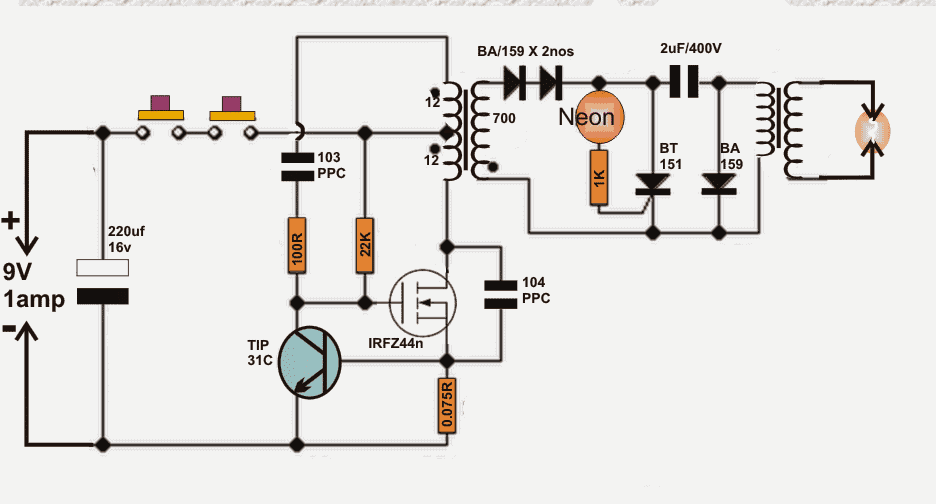Stun guns have been around for decades, but do you truly know how they work? Let’s embark on an electrifying journey to unveil the secrets behind these fascinating electroshock devices, from their basic workings to their science and history. Prepare to be shocked in more ways than one.
Short Summary
Stun guns are reliable and non-lethal electroshock device that temporarily incapacitates an attacker with a high-voltage shock.
Voltage and amperage, as well as legal considerations, must be considered when selecting the right stun gun for your needs.
Practical tips include researching safety instructions, proper techniques of use, and alternative defense tools available.
Understanding Stun Guns: The Basics

Stun guns have become an increasingly popular self-defense weapon, offering a safer, non-lethal alternative to firearms and knives. These devices are designed to deliver a high-voltage, low-amperage electric shock, temporarily incapacitating an attacker without causing permanent harm. Stun guns come in various forms, such as stun batons, stun belts (to control prisoners), stun gloves, and stun shields, each with unique features tailored to specific self-defense situations. They also come disguised as cell phones or pens. Many stun guns are about the size of a cigarette pack.
Purchasing stun guns is a wise decision for those looking to enhance their safety. They are reliable self-defense weapons.
Used by police officers and civilians alike, reliable stun guns have proven effective in subduing suspects and protecting individuals from potential threats. The key to their success lies in the electrical charge they emit, which disrupts the attacker’s nervous system and causes intense pain and muscle spasms. This answers the question: How do stun guns work?
To ensure safe and responsible use, it’s crucial to adhere to national and local laws, keep stun guns out of reach of children, and only use them when necessary.
Stun Gun vs. TASER Device
Though often used interchangeably, stun guns and TASER are different tools with unique characteristics and applications. Stun guns require direct contact with an assailant’s body, while TASER devices can be used remotely. They launch electrodes into the skin or employ a drive stun technique to insert probes directly into the attacker’s body. This difference in range and functionality makes TASER devices a popular choice for law enforcement and those seeking a self-defense tool with more reach.
Legal considerations also play a role in the choice between stun guns and TASER devices. In some countries, TASER are considered firearms and are subject to stricter regulations, while stun guns are more widely available. Additionally, stun guns are often more affordable and reusable, whereas TASER devices are single-use and require the purchase of spare cartridges.
Ultimately, the choice between a stun gun and a TASER device boils down to personal preference, intended use, and local laws. Tasers do have more power. They are considered less lethal weapons.
The Science Behind Stun Guns
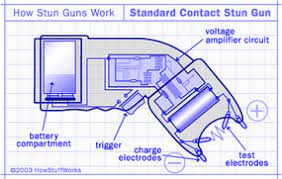
A stun gun’s core lies in a simple yet powerful concept: using electricity to disrupt the human body’s electrical system. The internal circuitry of most electroshock weapons, including stun guns, is composed of an oscillator, resonant circuit, and step-up transformer or a diode-capacitor voltage multiplier. These components combine to generate the high-voltage, low-amperage electrical current, making stun guns an effective self-defense tool.
Stun guns are designed to be easy to use and require minimal training. They are lightweight.
Electrical System Interaction
When a stun gun is applied to an attacker’s body, it disrupts the body’s electrical system, rendering the attacker temporarily incapacitated. Nerves in the human body transmit electrical pulses, and introducing an external electrical charge can interfere with these signals, causing a loss of muscle control in the application area. The charge produced by stun guns is approximately 4 milliamps, insufficient to cause significant harm unless applied over an extended time frame.
Tasers use pulse frequency to disable an attacker. Stun guns use pain compliance.
A study conducted by emergency medicine physicians at the University of California, San Diego, found no long-term impacts of TASER devices on healthy test subjects. This research supports the idea that stun guns and TASER devices are a safer alternative to other self-defense weapons, as they temporarily incapacitate an attacker without causing permanent damage.
Voltage and Amperage
Voltage and amperage play crucial roles in the effectiveness and safety of stun guns. Voltage is essential for penetrating clothing and delivering a shock, while amperage is critical for determining the duration of the shock. Stun guns typically have a voltage range in the millions today. However, it’s not the voltage that incapacitates, but the amperage.
Stun guns are an effective defense weapon. They need to deliver at least 4 milliamps of current for maximum efficiency. The distinction between volts and amps is important to understand: voltage is the measure of electrical pressure that allows electron flow, while amperage is the number of electrons. Together, voltage and amperage determine the power output of a stun gun, ensuring its effectiveness in temporarily incapacitating an attacker.
A Brief History of Stun Guns
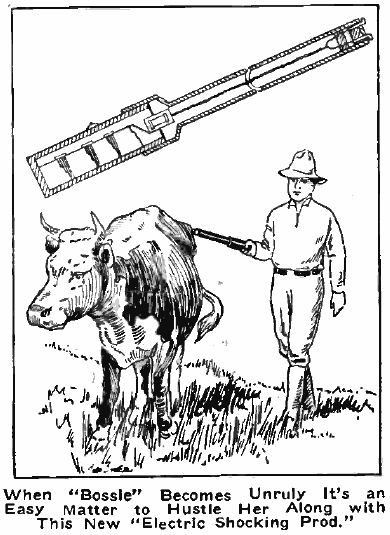
Stun guns have come a long way since their initial development in the 1930s. The first useful product based on the concept of stun guns was the cattle prod, a tool designed to control livestock. It wasn’t until the invention of the TASER device by Jack Cover, the first stun gun, that stun guns took on a more modern form, initially designed as an air safety device for use by marshals during flights.
Stun guns have evolved and diversified throughout the years, with various models and designs catering to different self-defense needs. Their influence on the contemporary world has been significant, as they are widely recognized as a reliable and effective method of non-lethal self-defense.
Events in the 1960s, such as anti-war protests and the Kent State Massacre, highlighted the need for police officers to have access to less-lethal alternatives like stun guns.
Click here for more history.
Practical Tips for Using Stun Guns
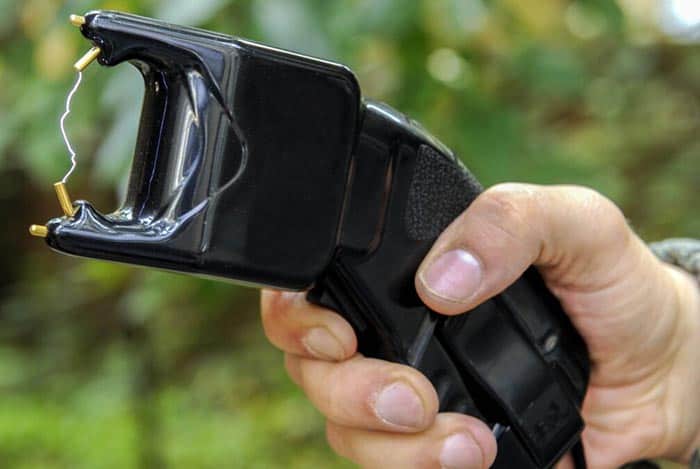
Before using a stun gun, it’s essential to conduct research and adhere to the manufacturer’s safety instructions. Proper handling, targeting, and deployment techniques should also be considered to ensure the stun gun is used safely and effectively. Remember, stun guns should be employed as a last resort, not an offensive weapon.
In addition to stun guns, alternative non-lethal self-defense tools, such as pepper spray and batons, are available. Depending on the situation and personal preferences, these tools can be used in conjunction with or as a substitute for stun guns. By familiarizing oneself with various self-defense methods and tools, individuals can be better prepared to protect themselves in dangerous situations.
Legal Considerations and Restrictions
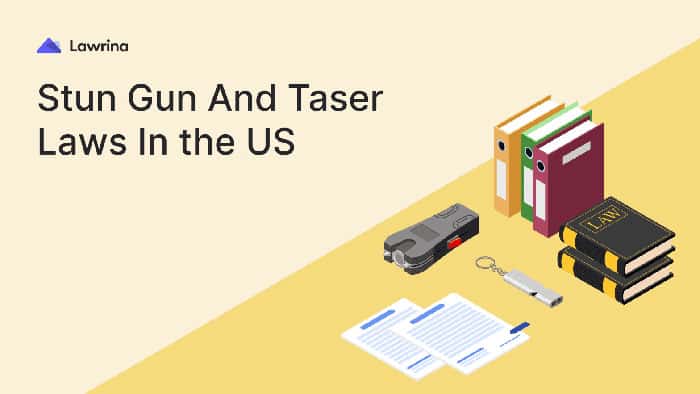
Stun guns and TASER devices are subject to varying legal regulations across different countries, states, and cities. For example, in Russia and China, civilian ownership of such devices is prohibited without a state license, whereas in Wisconsin and Illinois, possession is legal with a license. Certain cities like Chicago and Newark have bans or restrictions on stun gun possession.
Individuals must research and adhere to local laws regarding stun gun ownership, use, and possession in their respective jurisdictions. Legal requirements for owning TASER devices, such as age, residency, and registration with the police, should also be considered.
By staying informed and abiding by the law, individuals can use stun guns responsibly for self-defense.
Choosing the Right Stun Gun for Your Needs
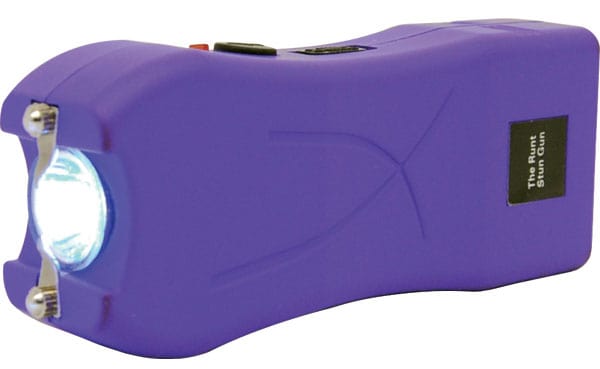
When selecting a stun gun, it’s important to consider factors such as size, power output, and additional features. The size of the stun gun will affect its portability and usability, so choose one that fits comfortably in your hand and can be easily carried like a spike stun gun. The device’s power will impact its effectiveness in deterring an assailant, so ensure it delivers a sufficient electrical charge.
Additional features, such as LED lights, alarms, and safety switches, can offer extra protection and convenience. By carefully considering these factors and researching available options, individuals can choose the stun gun that best meets their needs and preferences for self-defense.
Stun Gun Maintenance and Care
Proper maintenance and care are crucial to ensure the longevity and reliability of your stun gun. When recharging the batteries, use the charger that came with the device to avoid potential damage. Limit the use of the stun gun to short periods to prevent excessive discharge of electric currents into the air.
Use a dry cloth or a soft brush to clean your stun gun, avoiding oil or liquid cleaners. For optimal storage, keep the stun gun in a cool, dry location and remove the batteries when unused.
Following these maintenance tips can help ensure your stun gun remains a reliable self-defense tool for years.
Alternatives to Stun Guns – Other Self-Defense Products
Other devices and methods are available for those who may not be able or willing to use a stun gun. These alternatives include tasers, pepper spray, self-defense keychains, and personal alarms. Each device offers unique advantages and can be used in different self-defense situations.
It’s important to research and familiarize yourself with the various self-defense products and methods available and their respective legal restrictions. By doing so, you can choose the option that best suits your needs and preferences, ensuring you’re prepared to protect yourself in any situation.
Summary
Throughout this electrifying exploration, we’ve uncovered the secrets behind stun guns, delved into their science and history, and examined their various types and applications. We’ve also offered practical tips for using stun guns safely and effectively, discussed legal considerations and restrictions, and explored alternative self-defense tools. Armed with this knowledge, you’re now better equipped to make informed decisions about stun gun use and self-defense. Remember, knowledge is power, and in this case, it’s a power that can help keep you safe.
If this gets you interested in selling stun guns, start today.
Frequently Asked Questions
How long does a stun gun incapacitate you?
Being hit with a stun gun can incapacitate an attacker for 30 seconds if you can hold the stun gun on the attacker for 2-3 seconds.
The battery capacity of a stun gun can deliver a minimum of 30 discharges.
What does a stun gun do to the human body?
Stun guns disrupt the nervous system and cause muscles to seize up, inducing a state of neuromuscular incapacitation, which makes it difficult to make voluntary movements. The effects do not usually cause serious injury, but they bring extreme discomfort and pain.
What is the difference between stun guns and Tasers?
Both stun guns and Tasers are electroshock weapons. Stun guns require direct contact with the target, while Tasers can be used from a distance of up to 15 feet. This allows users to incapacitate an attacker before they are within striking distance, making Tasers a much more effective self-defense tool than stun guns.
Does a stun gun have to touch skin?
A stun gun does not need to touch the skin to be effective. It can go through normal clothing but not heavy clothing. You do need to touch the person with a stun gun.
What is the main purpose of a stun gun?
The main purpose of a stun gun is to provide a non-lethal self-defense option that temporarily incapacitates an attacker without causing any lasting damage. Stun guns are not designed to knock an attacker out but to disorient him long enough for you to escape and find help.


